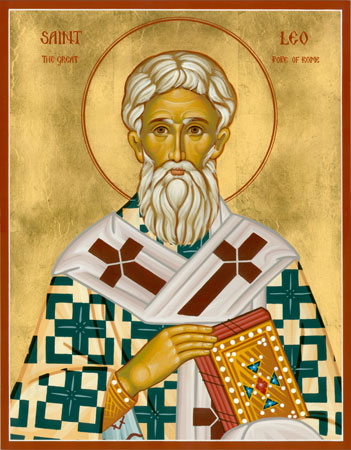

<this one needs revision:
check the text carefully>
| St. Ceril the Relentless | St. Bane the Scourger | St. Kargoth | St. Eleador the Survivor | Best of Dragon IV |
The DMG
mentions
“saints” in several places,
but no system is
given for defining sainthood
or classifying
the precise abilities or
capabilities of a saint.
Looking at the real world
and at saint-like
characters in mythology
and modern epic
fantasy, we might make the
following state-
ments about saints in AD&D™
gaming:
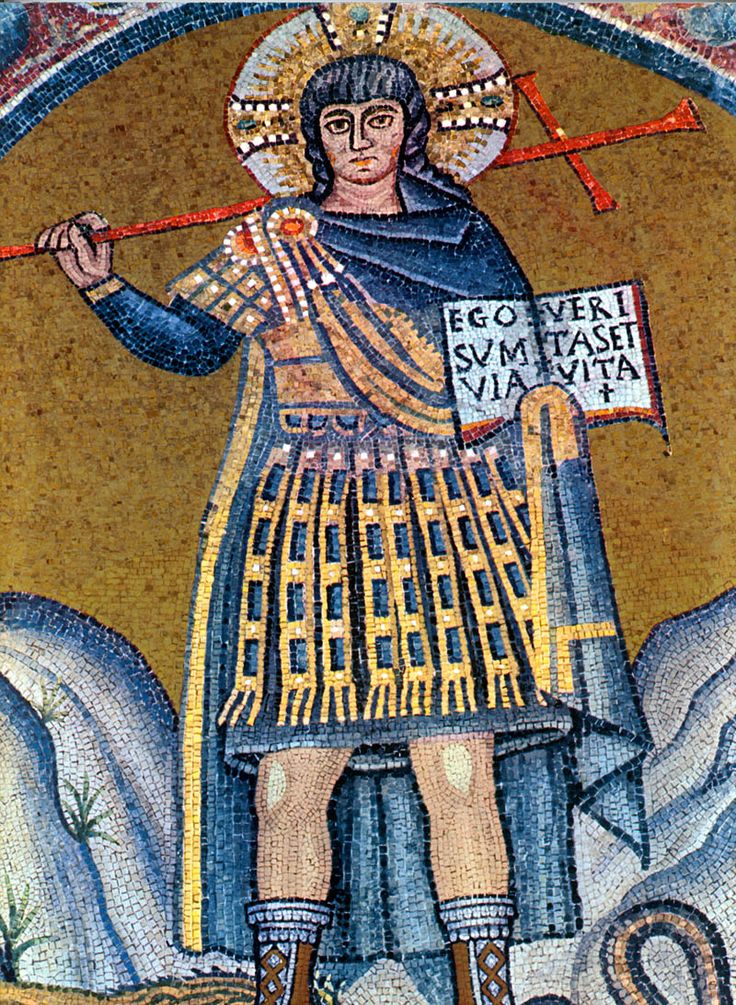
Saints are the most powerful
servants of a
deity on earth, the absolute
embodiment of
their religion, and as such
are given abilities
that far surpass those of
ordinary mortals.
Saints are almost always
clerics,
since that
character class provides
the most service to
the gods, but occasionally
a fighter, particu-
larly a paladin,
will be elevated to saint-
hood. Saints are usually
of good alignments
(the word “saint” is derived
from the Latin
sanctus, meaning
holy, as in “sanctuary”),
but there have been occasions
when the
evilest deities or the vilest
kings of the neth-
erworld have awarded their
dark champions
with saint-like power, resulting
in a “dark
saint” or “anti-saint.”
It has been said that becoming
a St. is
the most difficult goal
to which a mortal
may aspire.
It requires that the St.
serve
his (or her) deity faithfully
in every action
he performs, and that he
follow all the rules
of the religion unquestioningly.
In addition,
the saint must constantly
quest for and
smite the enemies of the
religion, and be
willing to die at any moment
for the sake of
the religion’s goals
without hope of rebirth;
the St. must also do deeds
of great valor
against great odds, and
be universally rec-
ognized as a champion of
the religion.
A saint should be far above
ordinary
mortals in power, with characteristics
much
greater than normal and
levels of ability
close to the peak of human
attainment (e.g.,
at least 16th level for
fighters
and
clerics).
The saint may be on very
close terms with
the gods, and will be well
versed in divine
politics so he can deal
with other divinities
and their servants to best
advantage.
If a mortal fulfills these
criteria, then his
deity or a group of sponsor
deities, provided
that they need a champion,
will empower
the saint with a spark of
divine essence so
that he is no longer truly
mortal, his power
being on par with a quasi-deity
(see DRAGON® issue #71).
As a non-mortal,
the saint must be a NPC.
If
a PC somehow manages the
near-impossible and is truly
worthy of
becoming a saint, then the
player should be
satisfied with his character’s
achievement,
and must let the character
pass into the
capable hands of the DM,
to be used for-
ever more as an NPC.
While the abilities of a
saint are as varied
as the gods themselves,
each saint being a
unique individual, there
seem to be some
abilities, listed hereafter,
common to all
saints. The number in parentheses
after a
listing indicates the number
of times per
day each of these spell-like
powers may be
used. Powers followed by
an asterisk (*) are
those that are used in reversed
form by an
evil saint (for instance,
continual darkness
instead of continual light).
Command,
1 round effect, no saving throw (1)
Continual
light* (3)
Cure disease/cure blindness*
(6 each)
Dispel
evil* (1)
Heal*
(1)
Immunity to death magic
spells and powers
Know
alignment (at will)
Protection from evil, 10’
radius* (at will)
Raise
dead* (1)
Reduced aging ¹
Remove
curse* (3)
Summon (1)²
Tongues/Comprehend
languages (at will)
True
seeing (1)
Notes:
(1) The saint will have 5
to 10 times the
lifespan of an ordinary
mortal, in addition
to being able to use life-prolonging
aids
available in the AD&D
universe (such as a
potion of longevity). Upon
his death, a saint
will go to reside upon an
Outer Plane
appropriate to his alignment
and religion.
(2) A saint can summon one
creature of
the same alignment
of not more than 12 HD.
This power is usable once
per week, as
opposed to all other “numbered”
powers,
which are usable the specified
number of
times per day.
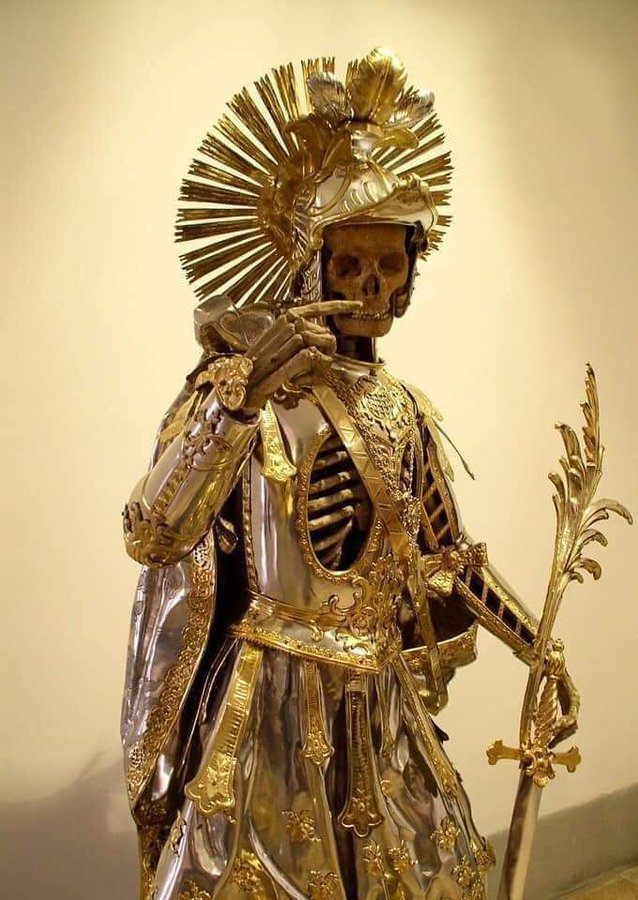
In addition to these powers,
a saint has
the ability to inspire awe
in creatures of 1
HD/level or less, as if
the saint were a
divine being with a charisma
of 19. This
awe ability is not dependent
on the actual
charisma of the saint, and
he may activate
this power at will. This
power also allows
high-level characters/creatures
to be aware
that the saint is a being
of more-than-
human power.
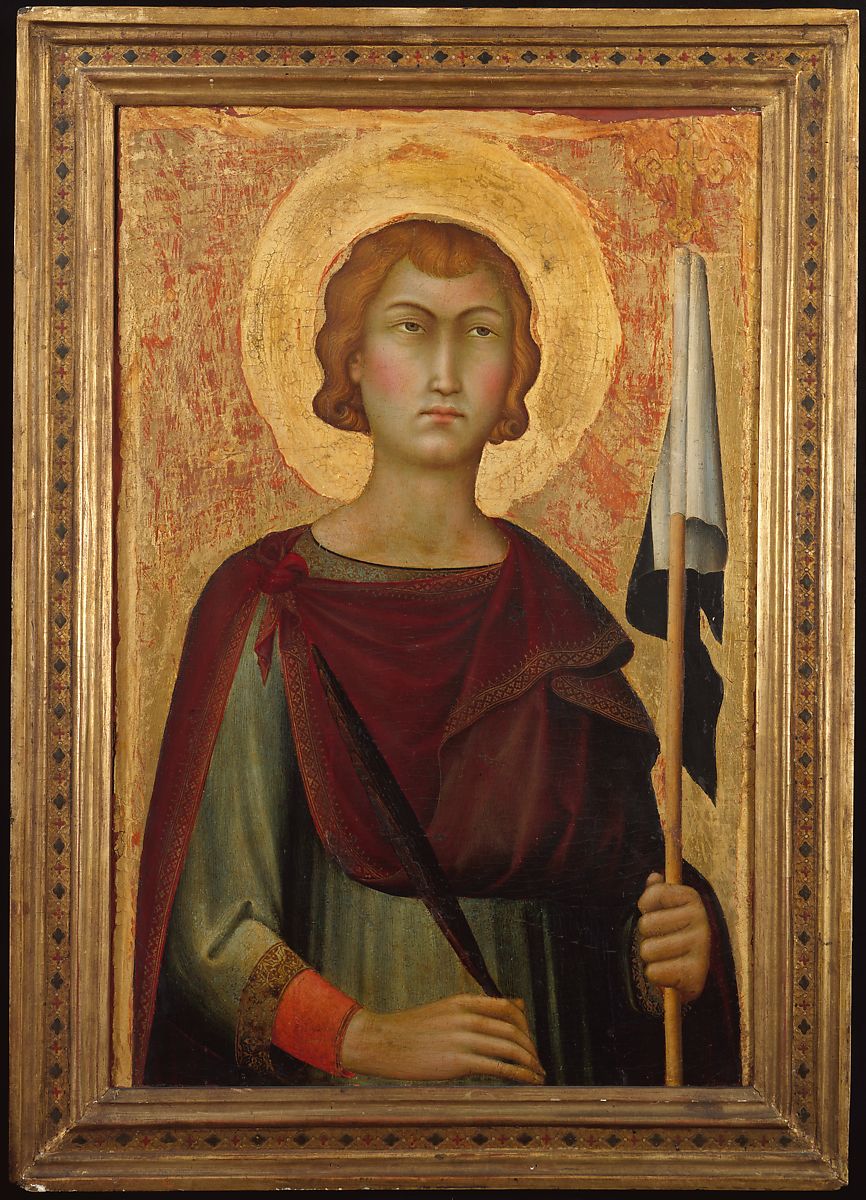
As a demi-deity, a saint
has a saving
throw of 3 in all categories.
A saint is likely
to have magic items of a
unique nature
(minor artifacts) or ordinary
magic items of
the greatest power.
Not all religions have saints,
while some
religions have. a large
number of “patron
saints” who serve as intermediaries
between
the deity and the deity’s
worshippers on a
number of matters. A patron
saint is the
most powerful variety of
saint, and actually
receives worship through
shrines located in
the major temples of the
patron deity. Those
saints who generate enough
interest that
cults are eventually formed
to honor them
may become demi-gods.
Saints, being of such great
power, should
be relatively few in number
on any one
world; a saintly encounter
is rare for even
the most travelled party.
Saints make inter-
esting aquintances — or
deadly enemies —
for player characters. As
examples, follow-
ing are four descriptions
of saints from my
own campaign:
St. Ceril,
who is of about average power for a saint;
St. Bane,
a patron saint who approaches demi-god status;
St. Kargoth,
a paladin gone wrong; and
St. Eleador,
who achieved sainthood extremely early in his mortal existence.
ST. CERIL
the Relentless
ARMOR CLASS: -7
MOVE: 12”
HIT POINTS: 98
NO. OF ATTACKS: 3/2
DAMAGE/ATTACK: By weapon
type (+2)
SPECIAL ATTACKS: See below
SPECIAL DEFENSES: See below
MAGIC RESISTANCE: Standard
SIZE: M (7 feet tall)
ALIGNMENT Lawful neutral
SYMBOL: Three upward-pointing
arrows
CLERIC/DRUID: 19th level
cleric
FIGHTER: 7th level fighter
PSIONIC ABILITY: VI
S 18 (+1, +2), I 16, W 19,
D 18
C 16, CH 19, CO 20
Ceril was an altar boy for
his religion in a
village where the entire
population, includ-
ing his parents, was slaughtered
by toad-
like creatures. Ceril, the
lone survivor,
vowed to avenge their deaths.
He spent fifty
years trying to accomplish
this, consuming
little food or water, hardly
sleeping, sustain-
ing himself only by an unceasing
fury.
Finally he found the murderers,
a group of
renegade Slaadi.
After a great battle, Ceril
singlehandedly slew their
leader, a very
powerful Death Slaad. Impressed
by his
devotion and perseverance,
Ceril’s deity
awarded him with sainthood.
Ceril has several special
weapons, the
greatest being Chaosbreaker,
a +5 long
sword that does double damage
against any
creature of a chaotic alignment.
His +3 plate
mail cannot be destroyed
or rusted, and has
the combined abilities of
a ring of swim-
ming, a ring of free action,
a necklace of
adaptation, and a helm of
underwater
action. His +2 shield will,
on command,
reflect a spell as does
a ring of spell turning,
seven times daily, one spell
per melee
round. He also has a plethora
of minor
magical items.
Ceril appears to be a man
of about 40
years of age, despite the
fact that he has
lived for more than 250
years. He has
golden hair, a short beard,
and grey eyes.
He is highly charismatic,
and can cast a
suggestion spell (once per
round) on any
creature of up to 6 hit
dice/levels merely by
speaking with the creature.
He is often
found questing against chaos,
and wander-
ing from place to place
preaching the
importance of strict devotion
to order and
the need to battle chaos,
a cause for which
he will occasionally employ
(and willingly
sacrifice) mortals as pawns.
ST. BANE
the Scourger
(Patron saint of those
who hunt undead)
ARMOR CLASS: -5
MOVE: 18”
HIT POINTS: 143
NO. OF ATTACKS: 3/2
DAMAGE/ATTACK: 3-12 (+9)
SPECIAL ATTACKS: See below
SPECIAL DEFENSES: See below
MAGIC RESISTANCE: Standard
SIZE: M (6 feet tall)
ALIGNMENT: Neutral good
SYMBOL: Flaming black trident
CLERIC/DRUID: 22nd level
cleric
FIGHTER: 10th level fighter
PSIONIC ABILITY: Nil
S 18/22 (+1, +3), I 20,
W 21, D 18
C 17, CH 19, CO 16
Saint Bane was the high priest
of a reli-
gion whose main precept
is the extermina-
tion of the undead. As a
first level cleric,
Bane incredibly managed
to slay three
vampires, and as he rose
in power he bat-
tled deadlier foes. Finally,
Bane was respon-
sible for the death of the
witch-ghoul
Khuul, one of Orcus’ greatest
servants, and
he attacked and nearly slew
Orcus on his
home plane. For his valor,
Bane was
rewarded with sainthood.
Bane has the standard abilities
of a saint,
and a lifespan ten times
longer than an
ordinary mortal; he appears
to be about 70
years of age. Any undead
of low intelligence
or less that even glances
at Bane must save
vs. death magic at -4 or
crumble into dust;
undead of higher intelligence
must make the
same saving throw or flee
in terror. Bane is
immune to aging, fear, charms,
paralysis,
or life-level loss.
In battle, Bane wields a
+6 flaming trident
that does a base of 3-12
points of damage
(+9) and triple damage against
undead. His
+2 plate mail makes him
immune to fire,
cold, and lightning attacks,
slow spells, and
magic missiles; his +1 shield
will deflect any
normal missile fire hurled
at him, including
boulders thrown by giants,
and it has a
35% chance of deflecting
missiles with a
magical bonus. He has a
few other magic
items of minor power. Bane’s
armor, shield,
and trident are transdimensional;
they do
not vary in power or ability
on different
planes.
Bane has a fairly widespread
cult, partic-
ularly in places heavily
infested with
undead. While he only has
a small and
rather weak priesthood (maximum
4th level
clerics), his clerics and
those who serve
Bane’s patron god that gain
Bane’s personal
blessing before questing
against
undead
have a 75% chance of gaining
+1 to all
undead-turning rolls, while
those who pray
at Bane’s shrine have a
15% chance to gain
a +1 to turn undead. This
blessing lasts for
the duration of the quest.
Bane is a wanderer of the
planes, and
often makes sorties into
the Abyss. His
plans are subtle and far-reaching,
and he
will often use mortals in
his schemes. He
appears as a man with wild
white hair, who
often rides a white beast
with the specifica-
tions of a nightmare of
maximum hit points
but which is neutral good
in alignment.
Bane has made a vast number
of powerful,
evil enemies; those who
ally with his cause
are asking for a lot of
trouble.
ST. KARGOTH (King of the Death Knights)
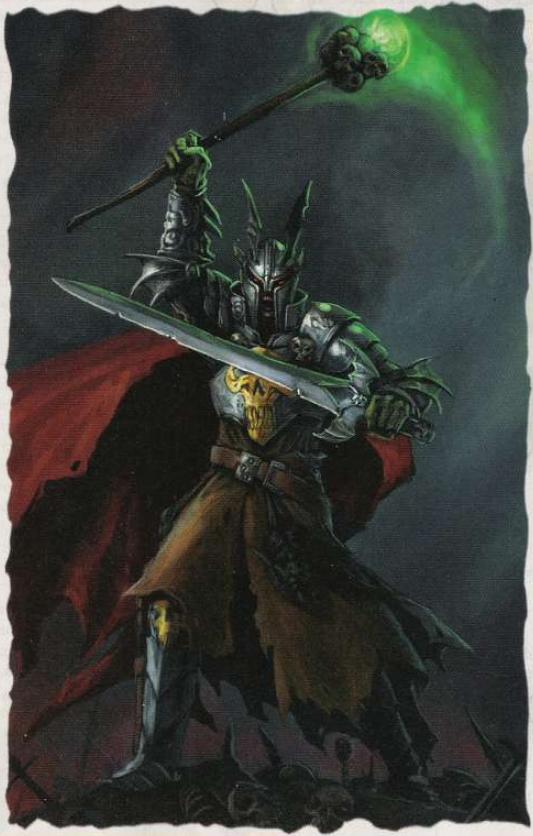
ARMOR CLASS: -5
MOVE: 15”
HIT POINTS: 136
NO. OF ATTACKS: 2
DAMAGE/ATTACK: By weapon
type (+8)
SPECIAL ATTACKS: See below
SPECIAL DEFENSES: See below
MAGIC RESISTANCE: 90% (see
below)
SIZE: M (7 feet tall)
ALIGNMENT: Chaotic evil
SYMBOL: Glowing green skull
CLERIC/DRUID: 12th level
cleric
FIGHTER: 16th level fighter
PSIONIC ABILITY: Nil
S 20 (+3, +8), I 18, W 15,
D 18
C 18, CH -1, CO -6
Kargoth was a great paladin,
until he
unleashed a demonic terror
on the Prime
Material Plane in a mad
bargain for per-
sonal power. The grateful
demon prince
transformed Kargoth into
the first and most
powerful Death
Knight. When the forces of
good rallied and drove away
the horror,
Kargoth exalted in his newly
won power
and performed many deeds
of great malevo-
lence and harm to the forces
of good.
Finally the scale of his
atrocities grew to a
point where the gods of
chaotic evil align-
ment could not help but
recognize his
achievements; needing an
agent to counter
the saintly agents of good
(such as St.
Bane), they endowed Kargoth
with saint-
like abilities.
Kargoth’s powers are many
and terrible.
He automatically commands
any undead he
encounters except those
directly serving
Orcus, and can summon two
Death
Knights
(see FIEND FOLIO™
Tome) at will once
per week, in addition to
his saintly sum-
moning ability. He has 90%
magic resist-
ance, and there is a 65%
chance that any
spell successfully cast
at him will be
reflected back upon the
spell caster.
Kargoth wears +4 plate mail
and wields a
variety of magical swords
of great power,
though he lusts for even
more powerful
weaponry. The only sword
in his long career
that came close to satisfying
him was
Gorgorin the Shatterer,
which does 2-20
(plus strength bonus) hit
points damage;
each victim it strikes must
save vs. death
magic or be disintegrated.
Fortunately, the
Shatterer was lost when
Kargoth battled the
legendary Hainard of the
Whiteguard.
Kargoth has never stopped
looking for the
sword since, and dark shall
be the day that
Kargoth and his beloved
sword are at last
one again.
Kargoth rides a glowing green
chariot
driven by six nightmares,
each of maximum
hit points. While in the
chariot, Kargoth
generates fear in a 120’
radius; outside the
chariot, Kargoth generates
fear in a 30’
radius, continuously. He
is capable of the
following additional powers,
usable one at a
time and one per round:
wall of ice, dispel
magic, darkness 20’ radius.
Thrice per day,
Kargoth can do each of the
following: gate
in a Type III (50%), Type
IV (35%), or
Type VI (15%) demon, with
a 100%
chance of the gate opening;
use any of the
power word spells, a symbol
of pain or fear,
and toss a 20-dice fireball.
These are in
addition to his other saintly
abilities.
Kargoth’s physical body was
driven from
the Prime Material plane
centuries ago, but
in his undead form he is
still able to venture
to the Prime Material plane
to wreak havoc.
While he serves Demogorgon
willingly, his
power is believed to approach
that of his
master’s, and his actions
in the complex
rivalries of the Abyss require
close scrutiny.
Kargoth appears to be a
Death Knight of
massive size and build,
except that his
skeletal features are a
baleful, glowing
emerald color.
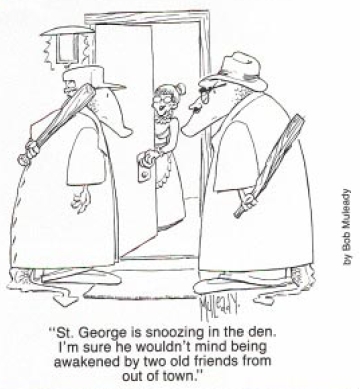
ARMOR CLASS: -4
MOVE: 12”
HIT POINTS: 88
NO. OF ATTACKS: 2
DAMAGE/ATTACK: By weapon
type (+1)
SPECIAL ATTACKS: See below
SPECIAL DEFENSES: See below
MAGIC RESISTANCE: Standard
SIZE: M (6 feet tall)
ALIGNMENT: Neutral good
SYMBOL: Golden chimera
CLERIC/DRUID: 17th level
cleric
PSIONIC ABILITY: VI
S 16 (+0,+1), I 18, W 20,
D 16
C 16, CH 16, CO 15
Eleador was a young priest
who was
thrust into circumstances
far beyond his
control, where he and a
small band of
adventurers were the only
ones who could
prevent the unleashing of
a monstrous evil.
Overcoming unbelievable
odds, he man-
aged to thwart the evil,
and several deities
gratefully rewarded him
with sainthood.
Eleador does not enjoy combat,
prefer-
ring peaceful resolution
of conflicts to
bloody violence. This makes
him all the
more dangerous when aroused,
and he will
not hesitate to attack the
most evil of foes.
Under no circumstances will
Eleador sur-
render or submit to blackmail;
he is willing
to see those he loves die
before he compro-
mises his principles. In
a battle, Eleador
wields the Mace of Auru,
a +3 mace of
disruption which dispels
evil on a natural
“to hit” roll of 18 or better;
he also owns a
talisman of pure good with
double the usual
number of charges. Like
St. Bane, Eleador
is a powerful foe of the
undead, gaining a +3
to his die roll to turn
undead creatures.
Eleador’s greatest power,
however, is his
gift of timesight. When
Eleador sleeps, he is
able to gaze into the past
and the future in
his dreams. The source of
this power is not
psionic; it has been speculated
by some
sages that a link exists
between St. Eleador
and the Plane of Time. It
is possible that
because of this link the
gods have taken a
great interest in his affairs,
which resulted
in his elevation to the
sainthood at a com-
paratively low level of
experience and with a
relatively weak reputation.
Eleador often wanders from
plane to
plane, but rarely uses disguises.
He appears
to be a man of about 30
years of age, with
blond hair and blue eyes;
he wears deep
blue robes over his chain
mail with the
insignia of a golden
chimera on his chest.
He has been known to ride
an extremely
powerful Pegasus
(AC 3, MV 12”/48”, HD
6+6, HP 54, #AT 3, D 2-12/2-12/1-4,
SD
10% magic resistance, immune
to petrifica-
tion) which he befriended
on a particularly
harrowing adventure.
THE FORUM
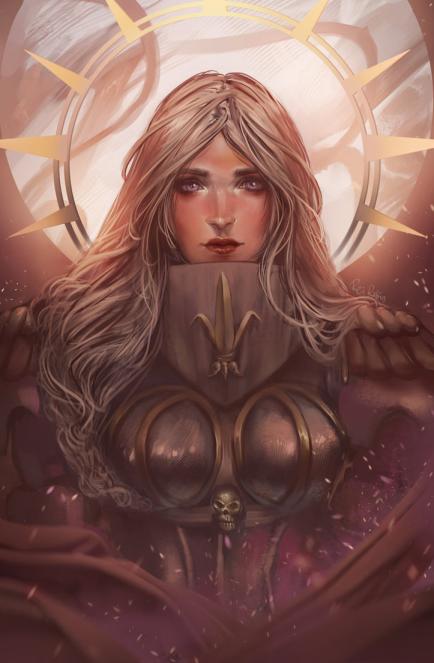
I?m glad to hear you?re allowing
more space
for readers? opinions in
DRAGON.
I?m also very
glad to hear that you call
such opinions ?letters,?
as letters can be handwritten
while other manu-
scripts have to be typed,
and I hate to type. So,
here?s my opinion on one
question ? I trust it
will be legible.
Why There's No Such Thing
as an Anti-
Paladin:
Gods differ greatly in how
easy it is to serve
them. The lawful good gods
are the hardest to
serve, since their service
goes against so many of
our natural instincts. A
couple of examples:
Self-preservation.
Modern policemen are
taught that if the choice
is between shooting the
villain when the shots might
hurt innocent by-
standers, or holding your
tire and maybe getting
shot yourself, you
don’t shoot. And if an evil man
takes hostages and demands
that you surrender
or he?ll kill them, you
surrender. (Of course, you
may negotiate, but not to
the point where he kills
one of them to add to the
pressure.) A chaotic or
neutral good character might
argue that killing
the hostage-takers, no matter
what happens to th
hostages, will ultimately
be the better course in
that it will deter future
hostage-takers. A lawful
evil or neutral character
might argue that every-
one is responsible for their
own actions, so if the
hostages were dumb enough
to get captured,
that?s their worry; I?ll
just kill the villains. But
neither of these is the
lawful good way. For the
lawful good character, defense
of the innocent
must come first; self-preservation
is secondary.
Self-enrichment:
Too much wealth in the hands
of too few people is a hallmark
of lawful evil ?
get all you can and hold
onto it, and don?t think
about all the impoverished
peasants who average
your money out. Lawful good
people can live
comfortably, but any extra
money goes to im-
prove the lot of their less
fortunate fellow crea-
tures. Hoarding and ?flaunting
it? are alike evil
traits; lawful good people
take what they deserve
and need, but no more. They
are good as well as
lawful.
I could go on ? for one thing,
I haven?t
touched on when killing
(i.e., vengeance) is
justifiable ? but
you should have the picture by
now. Being lawful good requires
great restraint
and goes contrary to many
of our basic instincts.
Therefore, the lawful good
gods give considera-
ble benefits to their more
loyal followers, both as
inducements to serve them
by following this
basically unnatural way,
and as rewards for
arduous services (suitable
recompense for services
rendered is definitely a
lawful good virtue).
Now, consider how one serves
the cause of
chaotic evil. It?s a
lot easier. If you have foes, you
can kill them, torture them,
enslave them, or do
what you will. If innocent
bystanders get you
don?t care. You can pile
up all the money you
want, not caring how many
people get impover-
ished in the process. In
short, being chaotic evil
places you under no restraints
whatever. It?s fun
(for those with the ?right?
? by which I mean
wrong — mentality,
of which there are very
many). So why would the
chaotic evil gods want
to reward one for having
fun?
And that’s why there
is no such thing as an
anti-paladin (or an evil
saint; see issue #79).
Ralph Sizer
Providence, R.I.
(Dragon #82)
* *
* *